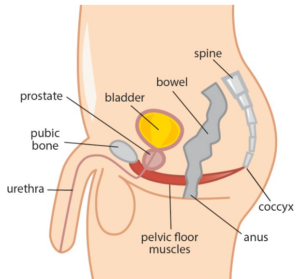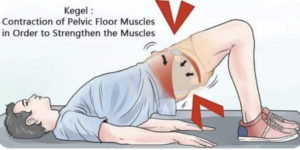Why Men Should Target Their Pelvic Floor Muscles During Their Next Workout
 Pelvic Floor Physiotherapy for Men… Is that a thing?
Pelvic Floor Physiotherapy for Men… Is that a thing?
Whilst we all have our favourite form of exercise to keep our body strong, lively and fighting fit, the pelvic floor muscles are quite often neglected, especially in the male population. The pelvic floor may be a foreign term to some men who correlate the relevance of this only with women who have been pregnant. However, it is just as important for men too… and yes, all men have a pelvic floor!
What exactly is the pelvic floor, and why is it important?
The pelvic floor is made up of a group of muscles that act as a hammock to support the bladder, bowel and prostate (the walnut-sized gland that surrounds the urethra where urine exits the bladder). They attach from the pubic bone at the front of the pelvis to the coccyx (tailbone) and to the left and right ischial tuberosity (sitting bones).
The muscles that make up the pelvic floor play a vital role in bladder and bowel function by preventing the leaking of urine and/or faeces. This is achieved by firmly wrapping around these passages to keep them closed (think about stepping onto a hose on concrete; with the pressure compressing the hose, no water can now escape out). When these muscles are strong, healthy and co-ordinate turning on/off well, they help keep men continent and allow optimal emptying of bladder and bowel on the next trip to the bathroom. A healthy pelvic floor also facilitates erectile function and sensation.
1 in 10 men will experience incontinence or pelvic floor issues. This greatly increases with age-related changes to the prostate, with up to 70% of men suffering from urinary incontinence following prostatectomy surgery/radiation therapy. Like all other muscles in the body, the pelvic floor can become weak, overactive or damaged during the lifespan. As these statistics can greatly impact the quality of life, all patients need to be empowered with education, information and access to appropriate services for treatment. Fortunately, there is great supporting evidence for rehabilitating and strengthening pelvic floor muscles correctly through pelvic floor physiotherapy for restoring bladder, bowel and erectile function.
How do I know if I am turning on my pelvic floor?
 As we can’t see these muscles due to their anatomical position deep in the pelvis, cueing is a great way to activate the pelvic floor muscles. Try the following cues at home:
As we can’t see these muscles due to their anatomical position deep in the pelvis, cueing is a great way to activate the pelvic floor muscles. Try the following cues at home:
- Imagine whilst you are emptying your bladder try and stop the flow midstream, then allow the flow to start again
- Imagine the sensation of walking into cold water and the sensation of the scrotum lifting upward and inwards
- Squeeze around the anus to prevent passing wind and relax
You should feel an upward and inwards lift of the scrotum and penis. You shouldn’t feel your abdominals, buttocks or inner thighs activating. If you are unsure if these muscles are activating properly, worry not – just like any other muscle in the body, it takes practice! Our pelvic floor physiotherapists are here to help ensure you are confident in finding and activating your pelvic floor correctly. With the use of real-time ultrasound, patients can see their pelvic floor function right in front of their eyes, helping to create a strong mind-muscle connection. For any pelvic floor-related changes, questions or concerns, head into MGS for an assessment today!
Please note the use of male & female pronouns is purely for anatomical reference.
